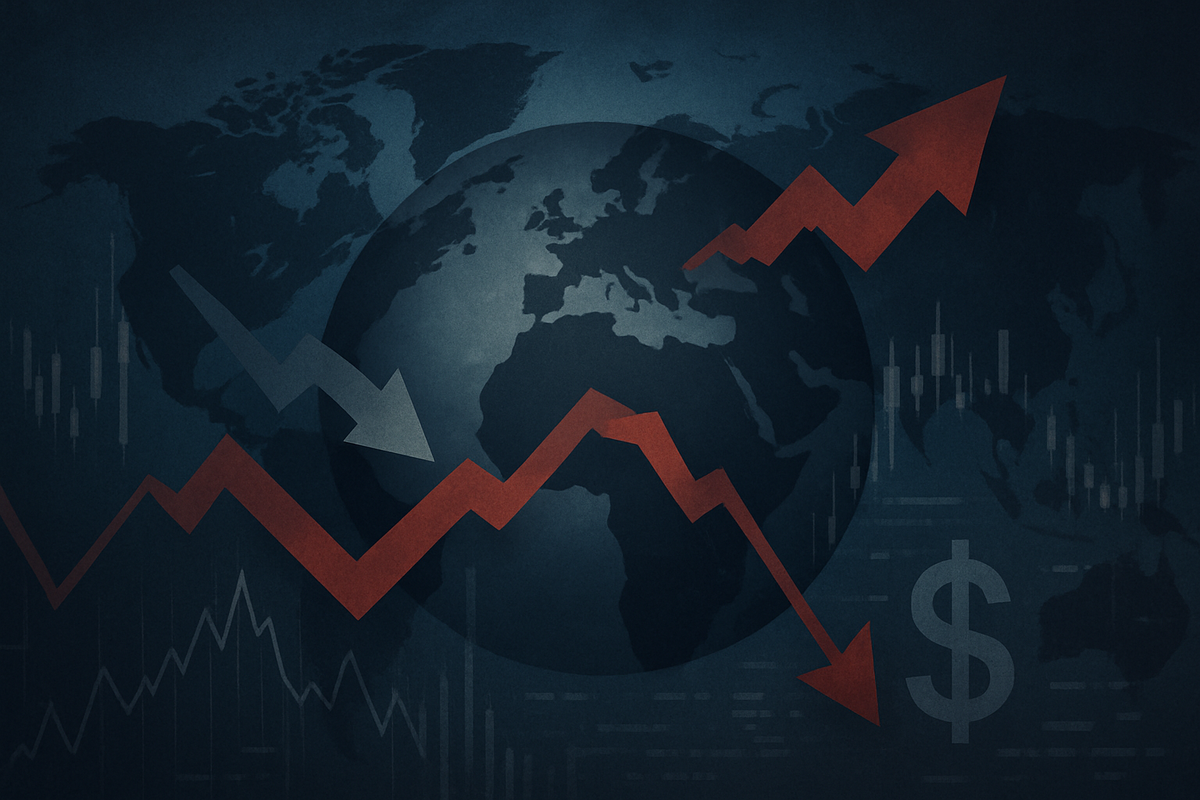
The global financial landscape in late 2025 is increasingly shaped by a complex web of geopolitical tensions, creating an environment of heightened uncertainty and volatility in stock markets worldwide. From the lingering shadows of the Russia-Ukraine conflict to the ongoing instability in the Middle East and the delicate dance of US-China relations, these events are profoundly influencing investor sentiment, commodity prices, and the very fabric of global supply chains. The prevailing sentiment is one where economic security often triumphs efficiency, leading to increased government intervention and a sustained period of market flux.
Investors are grappling with a new normal where geopolitical risks are not just external shocks but integral drivers of market behavior. The immediate implications include rapid shifts in asset prices, re-evaluations of corporate exposure, and a scramble for safe-haven assets. This era demands a nuanced understanding of international relations and their potential economic ripple effects, as short-term market reactions can be sharp, though historical data suggests a tendency for recovery if the broader economic impact remains contained.
A Deep Dive into the Geopolitical Landscape
The Russia-Ukraine conflict continues to exert a significant influence, particularly on energy markets. Since 2022, WTI crude oil and Brent crude prices have seen substantial surges, reflecting concerns over supply disruptions. Russian stocks have plummeted due to international sanctions and persistent uncertainty, with the MOEX index reaching its lowest levels since December 2024 by late October 2025. Major Russian oil companies like Rosneft (LSE: ROSN) and Lukoil (LSE: LKOH), alongside key banks, have experienced considerable declines in market capitalization. The conflict has particularly impacted European energy security, pushing energy prices higher and exacerbating food price spikes due to disruptions in Ukrainian grain exports. Conversely, the defense sector has flourished, with European defense spending projected to outpace that of the US, Russia, and China. However, even defense stocks have shown sensitivity to de-escalation talks, as seen in August 2025 amid whispers of a potential Ukraine ceasefire. While the direct revenue exposure of the S&P 500 to Russia and Ukraine is minimal, the indirect effects through energy prices and supply chain disruptions are considerable, squeezing consumer wallets and increasing business input costs. A potential peace deal, possibly brokered by the US, could trigger a stock market rally and temper commodity prices by facilitating the re-entry of Russian oil into global markets.
The Israel-Hamas conflict further complicates the global picture, fueling regional instability and impacting global energy and food security. Historical escalations in the Middle East have consistently led to rapid market volatility, causing initial downturns in major indexes and spikes in oil prices. For instance, an Israeli strike on Iran in June 2025 sent crude oil prices soaring and prompted a flight to safer assets. Conversely, a ceasefire agreement in October 2025 saw a rebound in Israel's Tel Aviv stock exchange (TA-125 and TA-35 indices) and a modest dip in global oil prices, illustrating the immediate market reaction to de-escalation. The energy sector remains highly susceptible to developments in the Middle East, given the region's pivotal role in global oil exports and shipping lanes. The defense industry, particularly in the U.S., has consistently shown a positive correlation between conflict intensity and stock market returns, indicating investor anticipation of increased demand for arms. Disruptions to critical maritime routes, such as those caused by Houthi attacks in the Red Sea, amplify the global psychological and economic impact, affecting shipping rates and potentially leading to tanker shortages. Continued volatility is anticipated, with markets poised to react swiftly to any shifts in hostilities. A sustained oil shock could fundamentally alter the economic landscape by fueling inflation and dampening demand.
US-China relations, a perennial source of geopolitical risk marked by trade tensions and tariffs, have seen a notable shift towards optimism in late October 2025. A "preliminary consensus" on a new trade deal, including a delay in new 100% tariffs on Chinese goods and a one-year postponement of China's rare earth mineral export restrictions, has injected a "risk-on" sentiment into markets. This development has propelled major American indexes (Dow Jones (NYSE: DIA), S&P 500 (NYSEARCA: SPY), Nasdaq (NASDAQ: QQQ)) to historic highs and stabilized global equity markets, fostering increased exposure to emerging markets and technology stocks. The technology and manufacturing sectors, with their significant exposure to the Chinese consumer market and reliance on global supply chains, are expected to benefit from reduced tariffs and enhanced stability. The semiconductor industry, heavily reliant on Taiwan, remains vulnerable to any disruptions in cross-strait relations. The rare earth minerals sector, a focal point of geopolitical competition, has seen a softening of critical mineral prices and a decline in American rare-earth company stocks due to the delayed export controls, lessening the immediate urgency for domestic supply chain development. Furthermore, China is expected to resume substantial purchases of US agricultural products, such as soybeans, benefiting American agricultural exporters. While this de-escalation could re-energize global supply chains, improving efficiency and reducing costs, underlying structural issues, such as China's dominance in rare earth materials and US export controls on critical software, persist, suggesting that the long-term competition for technological and economic supremacy will endure.
Winners, Losers, and Market Implications
The current geopolitical climate creates a clear divide between potential winners and losers in the global stock market. Defense contractors globally, such as Lockheed Martin (NYSE: LMT) and Raytheon Technologies (NYSE: RTX), are clear beneficiaries of increased defense spending driven by ongoing conflicts and heightened national security concerns. European defense companies, in particular, are poised for significant growth. Conversely, companies heavily reliant on unstable supply chains or with significant direct exposure to sanctioned regions, like those in Russia, face considerable headwinds.
The energy sector presents a mixed picture. While oil majors like ExxonMobil (NYSE: XOM) and Chevron (NYSE: CVX) can benefit from higher crude oil prices fueled by geopolitical instability, they also face pressure from potential de-escalation scenarios that could drive prices down. Furthermore, the push for energy independence in Europe and elsewhere could accelerate investments in renewable energy companies, creating long-term opportunities for players like NextEra Energy (NYSE: NEE) and Ørsted (CPH: ORSTED).
The recent positive shift in US-China relations is a boon for multinational corporations with substantial exposure to both markets. Technology giants like Apple (NASDAQ: AAPL) and agricultural exporters like Archer-Daniels-Midland (NYSE: ADM) stand to gain from reduced tariffs and increased trade stability. However, rare earth mineral companies outside of China, which had seen their stocks rise on the back of anticipated supply chain diversification, may experience a temporary setback as the urgency for domestic sourcing lessens. Companies in the semiconductor industry, such as NVIDIA (NASDAQ: NVDA) and Taiwan Semiconductor Manufacturing Company (NYSE: TSM), remain caught in the crosshairs of technological competition, with their long-term prospects tied to the delicate balance of cross-strait relations and export controls.
Broader Significance and Historical Context
These geopolitical events are not isolated incidents but fit into broader industry trends emphasizing resilience, diversification, and national security. The push for reshoring and nearshoring of manufacturing, already accelerated by the COVID-19 pandemic, is gaining further momentum as nations seek to reduce reliance on potentially vulnerable global supply chains. This trend has significant implications for logistics, manufacturing, and technology sectors, potentially leading to increased domestic investment and job creation.
The ripple effects extend beyond direct competitors and partners. Disruptions to key maritime routes, such as those in the Red Sea, affect global shipping rates, insurance costs, and ultimately, consumer prices for a vast array of goods. Regulatory and policy implications are also profound. Governments are increasingly intervening in economies, prioritizing national security over pure economic efficiency. This can manifest in increased subsidies for strategic industries, export controls on critical technologies, and stricter foreign investment reviews.
Historically, periods of heightened geopolitical tension have often been accompanied by increased market volatility. The Cold War, various regional conflicts, and past trade disputes offer precedents. While markets often demonstrate resilience and recover over time, the current environment is characterized by a unique confluence of factors, including persistent inflation, higher interest rates, and the rapid pace of technological change, which could amplify the impact of geopolitical shocks. The emphasis on "digital sovereignty" – governments seeking to control digital spaces, including AI, semiconductors, and quantum technologies – represents a new frontier in geopolitical competition with far-reaching implications for the tech industry.
What Comes Next: Navigating the Future
In the short term, markets will remain highly sensitive to any news of escalation or de-escalation in the ongoing conflicts. A sustained period of stability in US-China relations could provide a much-needed boost to global trade and investor confidence. However, the underlying strategic rivalry between the two superpowers is unlikely to dissipate, suggesting that tensions could resurface. Investors should anticipate continued macroeconomic volatility, with central bank policy rates likely to remain above pre-pandemic lows and consumer price inflation staying elevated in advanced economies.
Long-term possibilities include a further fragmentation of global trade into regional blocs, increased resource nationalism as nations prioritize securing critical minerals and energy supplies, and continued technological decoupling, particularly in strategic areas like AI and semiconductors. Companies will need to make strategic pivots, focusing on building more resilient and diversified supply chains, investing in cybersecurity, and adapting to evolving regulatory landscapes.
Market opportunities may emerge in sectors that benefit from increased government spending on national security, infrastructure, and domestic manufacturing. Companies that can innovate and provide solutions for energy independence, climate resilience, and digital security are also likely to thrive. Challenges include managing increased operational risks, navigating complex international regulations, and adapting to potentially higher input costs. Scenarios range from a gradual de-escalation of tensions leading to a more stable global economic environment to a more fragmented and protectionist world with persistent volatility. The evolution of cyber warfare as a new frontier of conflict also poses significant risks to financial stability and critical infrastructure.
Comprehensive Wrap-Up: Investing in a Turbulent World
The current geopolitical landscape presents a formidable challenge for investors. Key takeaways include the persistent nature of geopolitical risk, its pervasive impact across all sectors, and the need for a strategic and adaptable investment approach. While short-term market reactions to geopolitical events can be sharp, historical data suggests that markets often recover, underscoring the importance of a long-term perspective and avoiding impulsive decisions.
Moving forward, the market will likely be characterized by sustained volatility, elevated inflation, and higher interest rates. Investors should prioritize portfolio diversification across asset classes, sectors, and geographies. Investing in defensive sectors like utilities and healthcare, as well as safe-haven assets such as gold, can provide stability during uncertain times. Furthermore, identifying companies with strong fundamentals, diversified supply chains, and business models resilient to geopolitical shocks will be crucial. Industries that benefit from increased geopolitical spending, such as defense and cybersecurity, or those contributing to energy independence and critical resource security, may offer attractive opportunities.
In the coming months, investors should closely monitor developments in the ongoing conflicts, the trajectory of US-China relations, and any shifts in global trade policies. The increasing focus on resource nationalism, technological sovereignty, and cyber warfare will also be critical factors shaping the investment landscape. Building "geopolitical muscle" – the ability to understand and adapt to the evolving geopolitical environment – will be paramount for businesses and investors alike.
This content is intended for informational purposes only and is not financial advice





